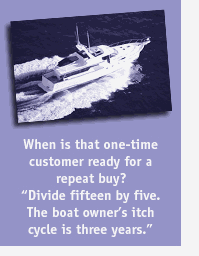
The Itch Cycle
| Продажи | ||||
| Sales.com | ||||
| Timing | ||||
by Graham Denton
Seeking leads in accordance with the "itch cycle" is a Tom Hopkins technique for securing repeat business. Noting that people generally get an "itch" to replace or upgrade purchases at regular intervals, Hopkins refers to that interval, or average turnover period, as a customer's "itch cycle." In real estate it's about four or five years, in automobile sales about every thirty months. Whatever it may be in your product or service area, you can appreciably increase your chances of getting repeat business if you anticipate when your customers are approaching their "itch" period and make yourself available for consultation at that opportune moment.
 To
do this effectively, you've first got to determine your customer's itch
cycle. Hopkins suggests that you do this by starting with your company
files and spending a day contacting former customers. What you want to
find out is not just when they last bought your product (you ought to
have that on file already) but how frequently, over the past decade or
so, they have bought and replaced that or competing products. Hopkins
gives the example of a boat company salesman who discovers that a given
customer has bought five boats in the past fifteen years. What's his itch
cycle? Divide fifteen by five. The answer is three years.
To
do this effectively, you've first got to determine your customer's itch
cycle. Hopkins suggests that you do this by starting with your company
files and spending a day contacting former customers. What you want to
find out is not just when they last bought your product (you ought to
have that on file already) but how frequently, over the past decade or
so, they have bought and replaced that or competing products. Hopkins
gives the example of a boat company salesman who discovers that a given
customer has bought five boats in the past fifteen years. What's his itch
cycle? Divide fifteen by five. The answer is three years.
Having determined the itch cycle, your next logical step is to start to prospect for that renewal just a little before the customer is likely to be ready. How much before? Hopkins recommends a sixty-day rule of thumb, but he also advises seasonal and personality adjustments.
The itch-cycle technique is really just a refinement of a broader approach to your customers: regular contact. Top salespeople never lose touch with their customers. They know the importance of follow-up, thank-you notes, and periodic visits. "If you don't maintain contact," Hopkins sensibly advises, "you don't have a clientele; your ex-buyers are abandoned soul looking for a new home." Get that home ready for them before they're ready to move in.